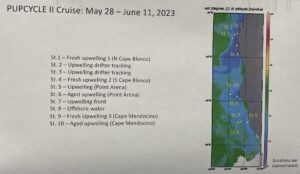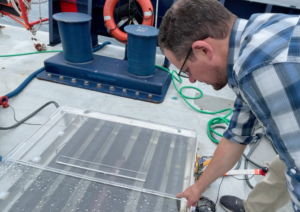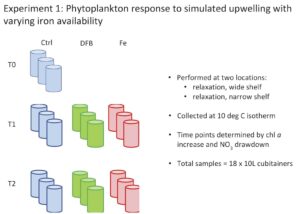Saturday, June 10, 2023 – Offshore North Pacific Coast (Latitude: 42.27.287 N, Longitude: 124.50.160 W)
Incubation Jubilation

The scientists are completing the data collection portion of their investigations. They have stored a multitude of samples from ten locations along the northwest coast of the United States. (See Figure 47 – PUPCYCLE II Stations.) The goal of the research team was to locate a new upwelling current and follow the current, and the phytoplankton drifting with the current, throughout the duration of the cycle. They succeeded in finding several upwelling plumes occurring along the Oregon and California coasts and were able to collect seawater samples near shore where upwelling cycles begin, along the upwelling drift as the currents moved away from the shore, and offshore where the upwelling cycles were nearing the end of productivity.

Some of the samples collected were filtered for biomass (e.g., the phytoplankton populations and communities) and the filters have been sealed in vials and stored inside an onboard freezer at -80ºC. These will be analyzed for DNA, RNA, and gene expression back at the various research institutions that participated in PUPCYCLE II. Other samples were used to conduct onboard incubation experiments prior to filtration and storage. (See Figure 48 – Incubation Experiment.)

These incubation experiments allowed the scientists to simulate upwelling and control the environment for the phytoplankton while assessing the level of productivity and chemical responses for the duration of the upwelling cycle. Incubation samples were filtered and stored at various time points during the cruise to capture phytoplankton responses to the chemical changes as the upwelling cycle ages. Both sets of sample data will give the researchers an insider’s look into the microbial world that fuels the aquatic food web.
